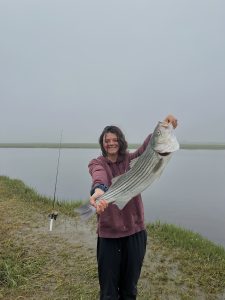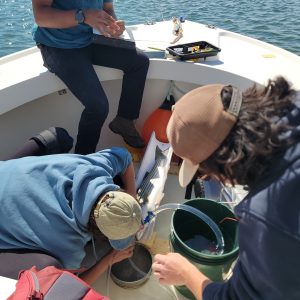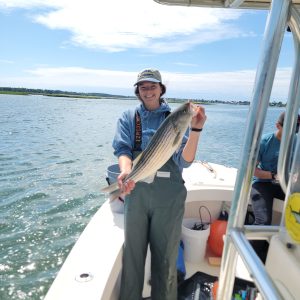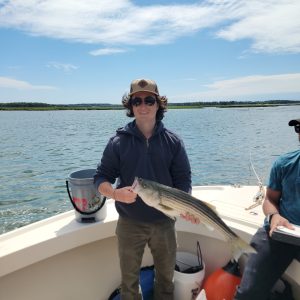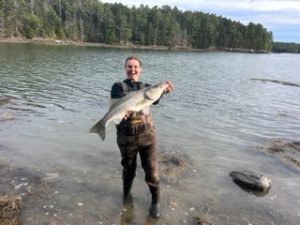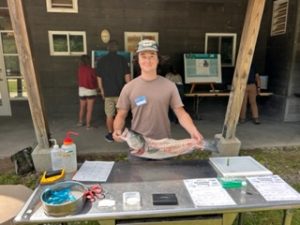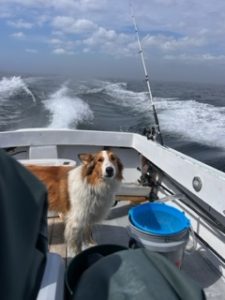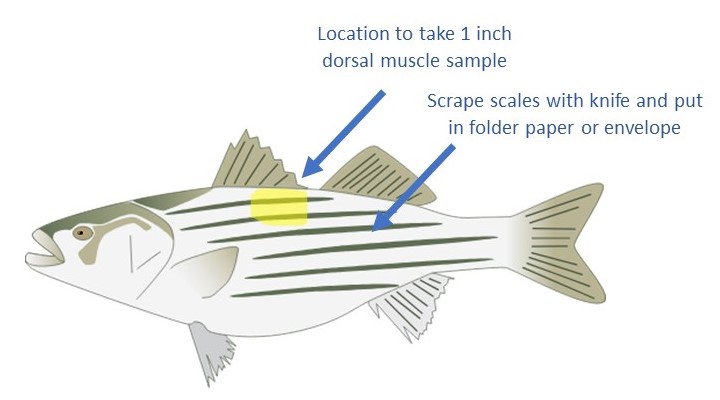Maine Striped Bass Foraging Ecology Study
Calling All Anglers: A UMaine Research Team Wants To Sample Your Striped Bass for Science!
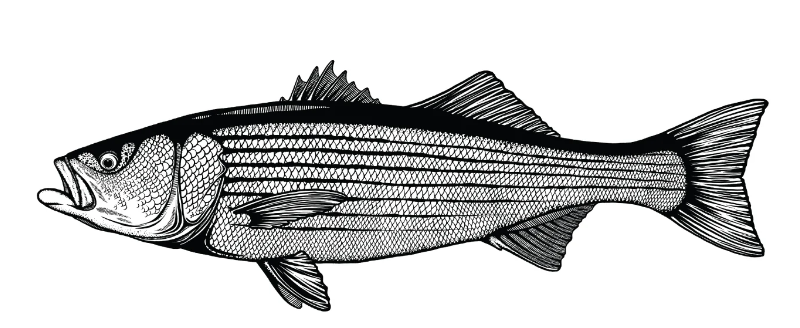
#GOTGUTS?

Project Information
A University of Maine research team is conducting the one of the first coastwide assessments of striped bass diet in Maine waters. While striped bass diet has been well documented in southern waters along the U.S. Atlantic coast, there has never been a comprehensive study of what they are eating in the Gulf of Maine! This project seeks to understand how striped bass diet varies across fish size, age, sex, location, and season.
Why is this Important?
- Filling a Data Gap
- Striped bass are managed by the Atlantic States Marine Fisheries Commission (ASMFC). In 2019 ASMFC listed the continued evaluation of striped bass dietary needs in relation to health condition as a high priority research recommendation.
- Foraging ecology studies help scientists understand the flow of energy throughout the food webs in Maine coastal ecosystems. Understanding how striped bass feed (seasonally and spatially) will allow us to make important trophic connections between the predator, their prey species, and overall ecosystem health.
- Striped bass are a highly migratory species, and we are interested in how their foraging habits and protein/lipid accumulation shift seasonally and along the coast.
- Contribution to Fisheries Management
- Striped bass are currently a rebuilding stock according to the ASMFC 2024 benchmark stock assessment, making this study timely in addressing important questions about their diets.
- This research can contribute to making informed fisheries management decisions that best support the conservation of the striped bass populations and their prey in Maine.
- Diet data can feed directly into more holistic ecosystem-based fisheries management. This can be used in future striped bass stock assessments as well as future prey species stock assessments (i.e. Atlantic herring, Atlantic mackerel, Atlantic menhaden).
- If we can quantify the abundance and size distribution of commercially harvested prey species that striped bass consume, this can contribute to natural mortality or predation mortality estimates and allow for further protection of key striped bass prey species.
We know how valued striped bass are ecologically, recreationally, and culturally in Maine. With your help, we can perform important research to contribute to their conservation and management efforts! Our research team will be partnering with the Maine recreational fishing industry and the public to gain striped bass samples in different rivers.
How Can You Help?
Charter Boat Captains
Can help by taking two trained field technicians out on a striped bass charter trip to collect stomach samples non-lethally (via stomach flushing). Please reach out to the project lead, Abby Remick (401-651-1034), for more information if you are willing to take us out with you!
Recreational Anglers
If you catch a legal sized striped bass (28-31″ TL) and donate your fileted racks with the stomach and other organs! Dropoff locations are listed below and range from southern Maine to Midcoast.
2025 Field Season Updates!
We are starting to wrap things up from our busy field season in 2025 and have successfully implemented our non-lethal sampling methods (gastric lavage) on board various charter boats! We are still trying to expand our sample size as the fall run continues so feel free to still donate fish. Please reach out if you are a charter captain that filets legal sized fish for your guests. We love picking up fish leftovers to turn them into science! We currently have about 280 stripers for the season and would love your help to keep that number going up –> maybe we can hit 300?!
Some pictures below from the 2025 field season…more lab photos to come!
Instructions to donate a striped bass:
1) Catch a legal sized striped bass (28-31″ total length; see ME DMR regulations for saltwater striped bass angling
2)Locate a local partner drop off location (see options below) or contact Abby Remick and she can help advise where to bring the fish
3) Put fish in plastic bag, keep on ice and/or freeze at nearby partner location
4) Label bag with date and location caught (materials provided @ partner spot)
5) Drop off at selected partner location
6) Text STB_location to 401-651-1034 so we know where to pick up!
If you don’t want to save the whole rack, put the stomach in a plastic ziplock bag and label the outside with date, location, length, sex (if known).
Our Partners:
Racks and samples can be dropped off at the following locations:
**If you want to deepen your involvement with participating in the study, please reach out to us via phone or email for further information/questions on this process. **
Check out a youtube short that one of our summer interns put together! Video credit: Gaddum Reddy.
What do the different organs tell us?
Any Questions?
Please feel free to reach out to us with any questions about the study or how you can participate!
Abby Remick (401) 651-1034, abrielle.remick@maine.edu
Michelle Staudinger (631) 664-7004, michelle.staudinger@maine.edu

